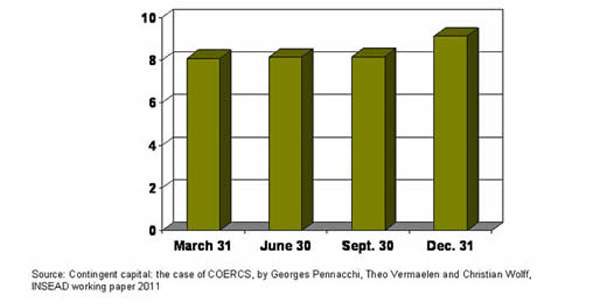
Fanning The Financial Crisis: Has Regulation Gone Wrong?
Far from being the classic “risk management tool”, government bonds today are beginning to look like toxic assets. And bailing out the governments issuing these bonds is tantamount to bailing out the banks… yet again. So hypothesises INSEAD Finance Professor Theo Vermaelen…
European taxpayers are asked to bail out Greece and other southern European countries to avoid a financial meltdown. The logic is that most Greek and other government debt are held by banks, so if we let these countries default the banks will default, so we are back to November 2008. So we are really asked to bail out banks, but given that banks are hated so much we are told that we are saving the Club Med countries and the European Monetary Union. However, the recent collapse in European bank stocks suggests that markets increasingly believe that German, Dutch and Finnish voters won’t agree to this second bank bailout in three years.
What's wrong with regulations?
I believe at least part of the answer lies in the way banks are currently regulated. Regulators force banks to have a minimum Tier 1 capital ratio. This ratio is defined as the ratio of book value of equity divided by risk weighted assets (RWA). Banks are pretty good in meeting this regulatory requirement: Figure 1 shows the average of these ratios for a sample of 50 U.S. banks in the crisis year 2008. Note that these ratios are calculated only each quarter, as they are based on book values. What is remarkable is the stability of this ratio, which hovers between 8 per cent and 9 per cent during the year. Based on this ratio, one gets the impression there was no financial crisis in 2008. However, market-based leverage ratios and credit default swap rates increased dramatically during this period and reflect the reality that everyone knows: there was indeed a financial crisis in 2008.
Figure 1 (see below) shows that capital regulation based on Tier 1 ratios is ineffective. If regulators want to regulate the capital structure of banks, they should encourage banks to manage capital ratios based on market values, not book values. If that was the case today, banks would be busy issuing equity rather than sitting on the sidelines hoping for a bailout that may never happen.
Figure 1: Mean 2008 Tier 1 Common Ratios of 50 Major US Banks in per cent

The problems are political
This contempt for markets and rating agencies is obviously politically driven: European politicians want to promote a united Europe where economic convergence is the rule. In such a world, there is no room for two-tier sovereign debt. The result, however, is that investors were given the impression that the EU will bail out countries when they get into trouble. This, in turn, has encouraged European banks to invest in Greek bonds, even if their credit spreads were only a few basis points higher than government bonds issued by other EU members. The current disappointment of investors that such a bailout may not happen (e.g. via the issuance of Eurobonds guaranteed by all members) is understandable: the behaviour of regulators implicitly assumed that such a bailout was more or less guaranteed.
The numerator of the capital ratio, the book value of equity, requires increasing profits, lowering payouts or convincing shareholders to put in more capital. The obvious way to manipulate the denominator is to avoid realising losses. Note that European regulators allow banks to value their investments at their nominal value, unless if they agree to a debt restructuring such as happened recently. For example, last week Commerzbank announced a write-off of 760 million Euros of Greek debt because it agreed to a voluntary bond swap as part of the second Greek bailout package. This loss was already largely anticipated by capital markets: Commerzbank’s stock price is trading at a 70 per cent below its level of one year ago. Hanging on to bad investments explains why the book value of a bank’s equity significantly overstates its market value. Banks hang on to bad investments, similar to individuals with extreme loss aversion: they believe they have not lost any money as long as they have not sold the asset. While behavioural finance researchers describe this as a psychological disorder, the behaviour of the banks is more likely to be explained by the desire to manipulate their book value-based capital ratios.
Regulatory Requirements are Surreal!
So we are now facing a surrealistic scenario: in order to meet regulatory requirements, banks have invested in and are holding on to Greek, Portuguese, Spanish and Italian bonds. Now that these investments have gone sour, tax payers are again asked to bail out the banks indirectly by bailing out these governments. Note the contrast with the previous crisis which was blamed on the greed of bonus-driven bankers who invested in excessively risky investments that were too complicated to understand. This time the trouble comes from being too risk averse: investing in plain vanilla government bonds that are considered safe because regulators declared they are safe. So this crisis is not a result of greed or a failure of capitalism. This crisis is the result of failure of government, in particular regulators. The obsession with “stable” accounting-based capital ratios turns out to be a major source of market instability.
It seems to me the real problem we have today is governments living beyond their means. Banks buying distressed government bonds appears to be a move to satisfy regulators and help governments stay solvent, but in fact this only encourages government profligacy.
But perhaps there is some hope for change: increasingly voters start worrying about government debt, because they realise that eventually they or their children will have to repay this debt through higher future taxes. Debt awareness may explain the failure of Keynesian borrow-and-spend policies. When the government borrows money and sends you a cheque, you no longer feel richer. So you won’t spend the money but save it for worse days to come. Moreover, people who don’t receive the cheque may feel they will have to pay for it, which also reduces their consumption. So something good may come out of this crisis after all: the nail in the coffin of the theory that government borrowing and spending creates wealth.
Theo Vermaelen is Professor of Finance at INSEAD.
[This article is republished courtesy of INSEAD Knowledge
http://knowledge.insead.edu, the portal to the latest business insights and views of The Business School of the World. Copyright INSEAD 2023]















